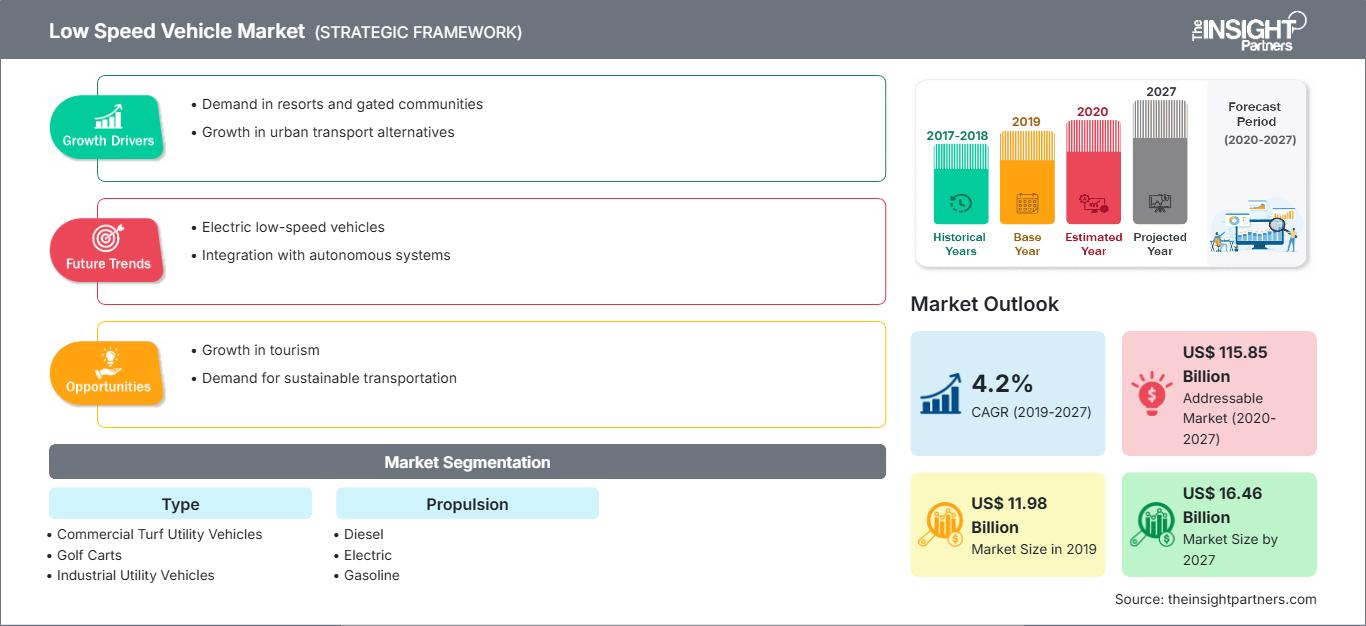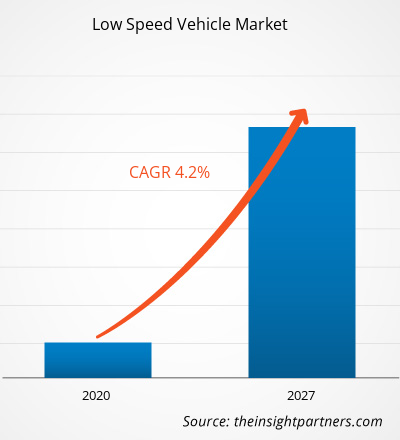Der Markt für Langsamfahrfahrzeuge hatte im Jahr 2019 einen Wert von 11,98 Milliarden US-Dollar und soll zwischen 2020 und 2027 mit einer durchschnittlichen jährlichen Wachstumsrate von 4,2 % wachsen und bis 2027 16,46 Milliarden US-Dollar erreichen.
Der Markt für Langsamfahrfahrzeuge hat in den letzten Jahren weltweit ein enormes Wachstum erlebt. Die positiven Wirtschaftsaussichten, steigende verfügbare Einkommen und die wachsende Bevölkerung zählen zu den Faktoren, die die Nachfrage nach Infrastrukturprojekten antreiben. Auch im Zusammenhang mit dem hohen Volumen an Online-Bestellungen wächst die E-Commerce-Branche, was zu mehr Lagerhallenbesitz in der Region führen wird. Langsamfahrfahrzeuge in den Lagerhallen unterstützen den Transport der Kisten von einem Ort zum anderen. Die oben genannten Faktoren spielen eine wichtige Rolle bei der Beschleunigung des Wachstums des Marktes für Langsamfahrfahrzeuge. Die Region APAC hatte 2019 den größten Marktanteil und wird voraussichtlich die am schnellsten wachsende Region im Markt für Langsamfahrfahrzeuge sein. Nordamerika und Europa sind die zweit- und drittgrößte Region im Markt für Langsamfahrfahrzeuge.
Der Ausbruch des Coronavirus begann im Dezember 2019 in Wuhan (China). Seitdem verbreitet es sich rasant auf der ganzen Welt. Zu den am schlimmsten betroffenen Ländern zählen China, Italien, Iran, Spanien, die Republik Korea, Frankreich, Deutschland und die USA. Der Ausbruch von COVID-19 und die daraus resultierenden Auswirkungen wie Grenzschließungen, Shutdowns und Reiseverbote wirken sich bereits auf Unternehmen in verschiedenen Branchen aus. Der Markt für langsame Fahrzeuge wird aufgrund der Unterbrechungen der globalen Lieferketten voraussichtlich mittelschwer betroffen sein. Die in diesem Markt tätigen Unternehmen werden kurzfristig (3–6 Monate) einen Rückgang der Gesamtumsätze verzeichnen, in den kommenden Jahren wird der Markt jedoch stetig wachsen.
Passen Sie diesen Bericht Ihren Anforderungen an
Sie erhalten kostenlos Anpassungen an jedem Bericht, einschließlich Teilen dieses Berichts oder einer Analyse auf Länderebene, eines Excel-Datenpakets sowie tolle Angebote und Rabatte für Start-ups und Universitäten.
Markt für Fahrzeuge mit niedriger Geschwindigkeit: Strategische Einblicke

-
Holen Sie sich die wichtigsten Markttrends aus diesem Bericht.Dieses KOSTENLOSE Beispiel umfasst Datenanalysen, die von Markttrends bis hin zu Schätzungen und Prognosen reichen.
Die Europäische Union, China, Japan, Kanada, Indien und Südkorea sind einige der wichtigsten Regionen, in denen Regierungen proaktiv Schritte unternehmen, um die Verbreitung von Elektrofahrzeugen zu fördern. In der Europäischen Union wurden beispielsweise die Kraftstoffverbrauchsstandards für bestehende Fahrzeuge erheblich verbessert. Für die Beschaffung von Elektrobussen durch den öffentlichen Sektor wurde eine „Richtlinie für saubere Fahrzeuge“ formuliert. Eine weitere Richtlinie namens „Richtlinie über die Gesamtenergieeffizienz von Gebäuden“ wurde ebenfalls erlassen, welche Mindeststandards für die Einrichtung von Ladeinfrastruktur in Gebäuden festlegt.
Antriebseinblicke
Der Markt für langsame Fahrzeuge ist nach Antrieb in Diesel-, Elektro- und Benzinfahrzeuge unterteilt. Das Segment der kraftstoffbetriebenen Fahrzeuge eroberte einen dominierenden Anteil am globalen Markt für langsame Fahrzeuge. Es gibt einen wachsenden Trend zu Hochleistungsfahrzeugen, die sich auf den zulässigen Straßen bewegen können und als Nutzfahrzeuge und Mannschaftstransporter eingesetzt werden können. Daher wird für den Prognosezeitraum ein deutliches Wachstum für langsame Elektrofahrzeuge prognostiziert, ebenso wie für langsame Hochleistungsfahrzeuge, die den Markt für langsame Fahrzeuge voraussichtlich ankurbeln werden.
Typeneinblicke
Der Markt für langsame Fahrzeuge ist nach Typen unterteilt in Nutzfahrzeuge für Rasen, Golfwagen, industrielle Nutzfahrzeuge und Mannschaftstransporter. Das Segment der Golfwagen hat einen dominierenden Anteil am globalen Markt für langsame Fahrzeuge. Viele Gemeinden in den USA sind stark auf langsame Elektrofahrzeuge angewiesen, um sich fortzubewegen. Für ältere Menschen kann das Gehen manchmal schwierig sein, während Autofahren beschwerlich und sogar unsicher sein kann.
Unternehmen ergreifen häufig Marktinitiativen und neue Entwicklungsstrategien, um ihre Präsenz weltweit auszubauen und die wachsende Nachfrage zu decken. Diese Strategien sind vor allem in Nordamerika und Europa zu beobachten. Die Akteure im Markt für langsame Fahrzeuge verfolgen eine Strategie der Expansion und investieren in Forschung und Entwicklung, um ihren Kundenstamm weltweit zu vergrößern und so ihren Markennamen global zu behaupten.
Langsamfahr
Regionale Einblicke in den Markt für Fahrzeuge mit niedriger GeschwindigkeitDie Analysten von The Insight Partners haben die regionalen Trends und Faktoren, die den Markt für Langsamfahrfahrzeuge im Prognosezeitraum beeinflussen, ausführlich erläutert. In diesem Abschnitt werden auch die Marktsegmente und die geografische Lage von Langsamfahrfahrzeugen in Nordamerika, Europa, im asiatisch-pazifischen Raum, im Nahen Osten und Afrika sowie in Süd- und Mittelamerika erörtert.
Umfang des Marktberichts für Fahrzeuge mit niedriger Geschwindigkeit
| Berichtsattribut | Einzelheiten |
|---|---|
| Marktgröße in 2019 | US$ 11.98 Billion |
| Marktgröße nach 2027 | US$ 16.46 Billion |
| Globale CAGR (2019 - 2027) | 4.2% |
| Historische Daten | 2017-2018 |
| Prognosezeitraum | 2020-2027 |
| Abgedeckte Segmente |
By Typ
|
| Abgedeckte Regionen und Länder |
Nordamerika
|
| Marktführer und wichtige Unternehmensprofile |
|
Dichte der Marktteilnehmer für Fahrzeuge mit niedriger Geschwindigkeit: Verständnis ihrer Auswirkungen auf die Geschäftsdynamik
Der Markt für Langsamfahrfahrzeuge wächst rasant. Die steigende Nachfrage der Endverbraucher ist auf Faktoren wie veränderte Verbraucherpräferenzen, technologische Fortschritte und ein stärkeres Bewusstsein für die Produktvorteile zurückzuführen. Mit der steigenden Nachfrage erweitern Unternehmen ihr Angebot, entwickeln Innovationen, um den Bedürfnissen der Verbraucher gerecht zu werden, und nutzen neue Trends, was das Marktwachstum weiter ankurbelt.

- Holen Sie sich die Markt für Fahrzeuge mit niedriger Geschwindigkeit Übersicht der wichtigsten Akteure
- Gewerbliche Nutzfahrzeuge für Rasenflächen
- Golfwagen
- Industrielle Nutzfahrzeuge
- Personentransporter
Markt für Fahrzeuge mit niedriger Geschwindigkeit – nach Antrieb
- Diesel
- Elektro
- Benzin
Markt für Fahrzeuge mit niedriger Geschwindigkeit – Nach Geografie
-
Nordamerika
- USA
- Kanada
- Mexiko
-
Europa
- Frankreich
- Deutschland
- Italien
- Großbritannien
- Russland
- Rest von Europa
-
Asien-Pazifik
- China
- Indien
- Australien
- Südkorea
- Japan
- Rest von Asien-Pazifik
-
Naher Osten & Afrika
- Südafrika
- Saudi-Arabien
- VAE
- Rest des Nahen Ostens und Afrika
-
Südamerika
- Brasilien
- Argentinien
- Rest Südamerika
Firmenprofile
- Bintelli Electric Vehicle
- Club Car, LLC
- Cruise Car, Inc.,
- Deere & Company
- HDK Co., Ltd.
- Moto Electric Vehicles
- Polaris Inc.
- Textron Specialized Vehicles Inc.
- The Toro Company
- Yamaha Golf-Car Company
- Historische Analyse (2 Jahre), Basisjahr, Prognose (7 Jahre) mit CAGR
- PEST- und SWOT-Analyse
- Marktgröße Wert/Volumen – Global, Regional, Land
- Branchen- und Wettbewerbslandschaft
- Excel-Datensatz
Aktuelle Berichte
Verwandte Berichte
Erfahrungsberichte
Grund zum Kauf
- Fundierte Entscheidungsfindung
- Marktdynamik verstehen
- Wettbewerbsanalyse
- Kundeneinblicke
- Marktprognosen
- Risikominimierung
- Strategische Planung
- Investitionsbegründung
- Identifizierung neuer Märkte
- Verbesserung von Marketingstrategien
- Steigerung der Betriebseffizienz
- Anpassung an regulatorische Trends






















 Kostenlose Probe anfordern für - Markt für Fahrzeuge mit niedriger Geschwindigkeit
Kostenlose Probe anfordern für - Markt für Fahrzeuge mit niedriger Geschwindigkeit